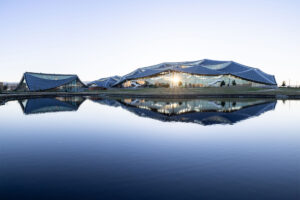
Obakki – A Purpose-Led Lifestyle Brand and Foundation
Founder Treana Peake, supports artisan partnerships and funds development work through the Obakki Foundation.
Canada
Mood of Living February 2, 2023
Called the ‘father of green roofs in North America’, Steven Peck is the co-founder of Green Roofs for Healthy Cities (GRHC), a non-profit industry association that is devoted to spreading awareness of the benefits of green roofs, walls, and other forms of living architecture. After studying political philosophy and economics at McGill University in Montreal, he worked in public policy for over a decade before being introduced to the idea of green roofs, and started Green Roofs for Healthy Cities shortly afterward. With the widespread implementation of green roofs and walls throughout a city, it can reduce energy consumption, extend the life expectancy of waterproofing membranes, and even cool down the overall temperature of the city itself.
Nearly 24 years since its creation, GRHC has flourished and has expanded its influence to reach across the globe. Peck’s devotion has helped cities like Toronto to fully embrace living architecture, with more than 10 million square feet of green roofs having been installed across the city.
The Green Infrastructure Foundation, co-founded in 2017 by Peck himself, acts as the charitable arm of Green Roofs for Healthy Cities — promoting the advancement and installation of green infrastructure through education and training for those wanting to learn more. Through online courses such as the Living Architecture Academy, GRHC offers a platform for education and training in a variety of subjects associated with green and living architecture. Steven Peck has also contributed his time to the World Green Infrastructure Network, a global organization for the advocacy and promotion of green infrastructure in urban planning that now has 28 member states — each individually dedicated to the goal of worldwide implementation of green infrastructure.
Mood of Living: Where did you grow up? Where do you live now?
Steven Peck: I grew up in mid-town Toronto, Canada, and currently live in The Beaches, Toronto close to Lake Ontario — lakeside parks and beaches.
MoL: As a child and young adult, were you drawn to the natural environment?
SP: Toronto is blessed with an enormous ravine system, many of which have streams and rivers flowing through them. As a youth, our parents gave us much more freedom to roam than children typically enjoy today, and we spent a lot of that time playing in the forested ravines.
MoL: Where did you go to college and what did you study? Was there a person or experience that influenced your passion for sustainability and community development?
SP: I went to McGill University and studied Political Philosophy and Economics. There was one lecture given by Professor James Tully about a deep ecology critique of our current system of resource exploitation which influenced me greatly. Essentially the world’s resources are finite and yet we have built a society and economy that is essentially liquidating them to meet our short-term needs and desire for endless growth. Something has to give with this unsustainable approach and it’s not likely to be the natural world.
MoL: What jobs did you have before founding your organization?
SP: I started and ran a small company that did renovations and maintenance work when I was 16. After university, I worked as a public policy consultant for ten years at Thompson Gow & Associates, prior to starting my own firm, Peck & Associates. In 1997 I was introduced to the concept of green roofs and started Green Roofs for Healthy Cities shortly afterward.
2020 Award-Winning Projects: Center For Sustainable Landscapes: District House Apartments. Garden House, McDonald’s Headquarters, Sandyland
MoL: What inspired you to create Green Roofs for Healthy Cities? Did your professional career prior to creating your organization influence this decision? What was the process of creating the organization? What is your organization’s purpose and mission?
SP: In order to overcome the challenges associated with creating a new industry, it is critical to get the early adopters, the firms already engaged in green roofs, to work together for a common purpose. That purpose was to build a green roof on the Podium Deck of City Hall in Toronto, in order to demonstrate the technology, conduct performance research and move towards supportive policy. Toronto was the first major city in North America to make green roofs mandatory for most types of new development. Eleven years later Toronto now boasts having more than 10 million square feet of green roofs installed across the city. I have been called the ‘father’ of green roofs in North America.
MoL: What resources do you provide the members of Green Roofs for Healthy Cities? What professions do your members work in?
SP: We provide marketing and promotional support for our members, and work to continue to develop the industry through professional training (see www.livingarchitectureacademy.com), as well as advocacy support to help governments implement new policies. We hold events in various markets to engage policymakers, NGOs and design professionals about the incredible potential of green roofs and walls. We are also actively involved in establishing voluntary standards, such as the Living Architecture Performance Tool, which is a third-party performance rating system for green roofs and walls. (see www.greeninfrastructurefoundation.org)
MoL: What is the difference between green and living architecture?
SP: Green architecture refers to a broad range of products and designs that provide either a reduction of harm or a benefit to the environment. So energy-efficient windows or low VOC paints would be in this category. Living architecture refers to technologies that allow us to grow plants on the building envelope and inside buildings – principally green roofs and green walls.
MoL: What is the Living Architecture Academy? What kind of courses are offered? Is the Academy accredited? What other training do you offer on your platform?
SP: The Living Architecture Academy is our online training platform which allows people to learn more about a wide range of subjects associated with living architecture and green infrastructure. There are free courses, the Green Roof Professional (GRP) training and accreditation, and a wide range of additional subjects including urban agriculture, biophilic design, blue-green roofs and more. The GRP is an accreditation program which involves three days of lectures online, a digital resource manual and an online exam, which students must pass in order to earn the accreditation.
MoL: Where are your events and to whom are they catered? What are they about?
SP: We have both in-person events, such as our annual conference, awards and the trade show – Cities Alive, which moves around to different cities each Fall. We also have virtual events that bring experts together to discuss specific topics, such as biophilic design, or water management. They are focused largely on design professionals, but we also attract researchers, NGOs, policymakers, manufacturers, and contractors.
MoL: You developed the Living Architecture Performance Tool. What is this tool and who uses it?
SP: This is an easy-to-use rating system that allows designers to work to obtain the maximum number of benefits from their green roof and/or green wall project. It can also be used by owners or designers for third-party certification of a project’s performance. Credits are awarded in eight areas – such as water management, energy, and social equity – based on the process and elements of the project. They are submitted and reviewed by technical staff at the Green Infrastructure Foundation and points are awarded to determine the level of third-party certification. The LAPT certification also has several minimum requirements, such as demonstrating a plan and budget for at least five years of maintenance.
MoL: What is the Green Infrastructure Foundation? What does the Foundation do? What is its mission?
SP: The Green Infrastructure Foundation is the charitable arm of Green Roofs for Healthy Cities. Its mission is to promote all forms of living and green infrastructure, and to that end, it has a very successful Green Infrastructure Charrette program. This combines training on green infrastructure, how to establish monetary values for it, and a day to redesign an area in the community with various green infrastructure elements. Afterward, a cost-benefit of the proposed changes is developed, and the final report can be used as an advocacy or planning tool.
2021 Award-Winning Projects: Coastal Cottage – NewYork GreenRoofs, IGA Duchemin Urban Rooftop Farm – Soprema Canada, Old Chicago Post Office -Hoerr Schaudt LandscapeArchitects, Powder House Aerial
MoL: What is the World Green Infrastructure Network? Who are its members and what is the company’s purpose?
SP: WGIN is a non-profit association of international green roof industry associations. It currently has about 28 member states and they exchange best practices during their annual World Green Infrastructure Congress. The next one will be held in Berlin in June of 2023.
MoL: How important is it for architects and urban planners to bring nature into urban areas, integrating living spaces into their designs? How does preserving biodiversity through green roof and wall design impact overall human productivity, health, and happiness?
SP: One of the best ways to prepare for the worsening impacts of climate change is to adapt our communities. Living architecture, widely implemented, is able to address issues such as the urban heat island, and extreme weather events like heavy rainfall. It also sequesters carbon and reduces energy consumption in buildings while creating local green jobs.
Healthier cities, those with access to vibrant green space, are places where people want to live, so this supports intensification and reduces development pressure on surrounding farmland and natural infrastructure like wetlands and forests. Living architecture allows us to grow our cities up, rather than out. But we can’t grow up without high-quality living environments, like roof parks.
A growing body of scientific literature in multiple fields demonstrates how access to green space makes us happier, more productive, healthier, and more likely to help out a neighbor in need. The premise behind the biophilia hypothesis is that we need to have exposure to natural areas and other natural features, such as sunlight and water, in order to be healthy. We are genetically predisposed to want to spend time in nature, and when we don’t, it has an adverse impact on our minds and bodies.
MoL: Is water reused in most green roofs and green spaces? If so, how does this work? How important is it for green architects and urban planners to consider incorporating water management into the design of buildings and communities?
SP: Net Zero Water is a difficult design goal to achieve. Living systems need water in order to survive and to provide benefits such as cooling through evapotranspiration, and biodiversity. It is possible to design a green roof to survive only on rainwater, through a careful selection of plants and growing media and a willingness to allow plants to go dormant. Climate change is making this more difficult, so we recommend a supplemental source of water be made available, to be able to deal with prolonged periods of drought. Irrigation-free living green walls are very difficult to achieve. Green walls typically require ongoing irrigation to remain healthy. More and more, designers are looking to alternative sources of water for irrigation, such as rainwater storage and capture. Blue-green roof technologies can, for example, store water on the roof and use it to provide supplemental irrigation to the plants above. Other projects have captured condensate from air conditioning units and used it for irrigation. We have a detailed training course and resource manual on the Living Architecture Academy called Net Zero Water, which goes into these opportunities in much more detail. www.livingarchitectureacademy.com
MoL: Does it cost more for building owners to incorporate green roofs and walls into their buildings and spaces?
SP: Yes. The real question is, what benefits can I derive for the building owner by investing in these systems! That is why professional training is so important. These systems can help buildings meet regulatory requirements, for green space or stormwater retention and detention for example. Green roofs and walls can improve the productivity of employees, a bottom-line saving. They can express a corporate philosophy or contribute directly to the bottom line by increasing rents – a roof park is an amenity that people will pay more for. There are so many different benefits, designers need to work through the options for each project and make a case. We teach this through the Green Roof Professional accreditation, which requires three days of training, involves a 1,000-page Resource Manual, and passes a two-hour online exam. See www.livingarchitectureacademy.com
MoL: How does the development of living architecture impact climate change? How have you advocated for changing governmental policies and standards through living architecture initiatives? What changes do you hope to see happening in governmental policies around the world?
SP: Project Drawdown, an initiative by Paul Hawken to pull greenhouse gases out of the atmosphere by 2050, lists 100 measures to do so and green roofs are included as number 73. Widespread green roof implementation can actually cool down cities, thereby reducing the energy and associated greenhouse gases used for air conditioning. Green roofs also significantly extend the life expectancy of waterproofing membranes, helping to avoid the embedded greenhouse gases and the waste associated with frequently reroofing buildings. On existing buildings, green roofs and walls can reduce heat gain and loss through the building envelope, thereby reducing energy use.
Every year, more and more governments are either making green roofs mandatory or providing incentives for them. For example, cities like Toronto, New York, Cambridge, Washington, DC, Chicago, and Portland, Oregon all have mandates and or policies in place that specifically support green roof design and installation. This is largely because green roofs provide both public and private benefits, and can address so many pressing issues in cities, simultaneously. Biodiversity, stormwater management, air quality, food security, urban heat island mitigation, flood mitigation, access to green space and the list goes on. From a public policy perspective, no form of infrastructure can provide the same public ‘bang for the buck’ as green roofs.
MoL: With so many benefits to living architecture, why are some cities slow to incorporate green roofs and walls into their architectural designs?
SP: In some places, there are concerns that requiring green roofs, or other elements that have a public component, like art, will drive developers away. They will simply pick up and go elsewhere. In other cities, there is a culture that seeks to limit public oversight of the development process – a private sector knows best attitude! In these communities, one of the best places to start is by including green roofs on publicly owned or financed buildings, and then work out from there. Walk the talk first, then introduce incentives and mandates.
2022 Award-Winning Projects: 4131 SouthState, 5665 Woodlawn, Drexel University, Javits Farm
MoL: What is biophilic design? What is biophilic holism? How important is it for the architect to consider the principles behind these terms in architectural and urban planning?
SP: Biophilic design seeks to implement various biophilic elements into a project in order to achieve a healthier, more sustainable outcome for building owners, visitors and occupants. Biophilic elements include things that science is telling us to improve our well-being. Natural light, water features, green walls, shelter, perspective, bird song, wood, stone and other natural building materials are just a few of these elements. In a best-case scenario, all of these elements have to work together, which is where holism comes into the picture. Biophilic ideas are being translated into urban planning, by the Biophilic Institute.
At Green Roofs for Healthy Cities, we have some really fantastic and inexpensive lectures on Biophilic Design from some leading practitioners including Bill Browning and Elizabeth Calabrese. See the Living Architecture Academy. There is also a great article on biophilic design in the Living Architecture Monitor magazine by Elizabeth Calabrese in the current issue. www.livingarchitecturemonitor.com
MoL: What advice do you have for the next generation who want to have careers in green architecture and sustainable community development? What kind of degree/s should they be aiming for? Architecture? Environmental Science? Conservation Biology, Horticulture? Public Policy? MBA? Law? How do they know which avenue to take?
SP: In terms of power and influence over the built environment, I think that developers have the most influence, followed by Engineers, Architects and Landscape Architects. Planners are important, but often don’t have a tremendous amount of influence, subject as they are to the whim of politicians. They need support from the industry.
Regardless of the type of degree you engage with, it is of utmost importance to remember that we can accomplish a lot if we continue to push hard for change in the built environment. Not only does the built environment have an enormous impact on how sustainable or unsustainable we are, but it also actually shapes how we perceive the world and how we will relate to it in the future.
The preservation of natural green infrastructure in our regions by growing up rather than out; combined with the ecological restoration of degraded environments; and the rapid expansion of living architecture in, on, and around our buildings is critical – not only to our future well-being but also to our very survival. One of the things people can do is ask their local political representatives if they have policies that support green roofs on new and existing buildings, and if not, why not? We all have a role to play to ensure that future generations can live a healthy and enjoyable life and that there is room in our world for the many other species that exist alongside us.
Photography courtesy of Steven Peck

Founder Treana Peake, supports artisan partnerships and funds development work through the Obakki Foundation.

Trained as a scientist and ornithologist, Dr. Gray is the first woman to hold the title of CEO in the organization’s 117-year history.

Leading sustainable architect working on scalable innovations to deliver on Google’s 2030 Carbon aspirations and the hybrid future workplace.